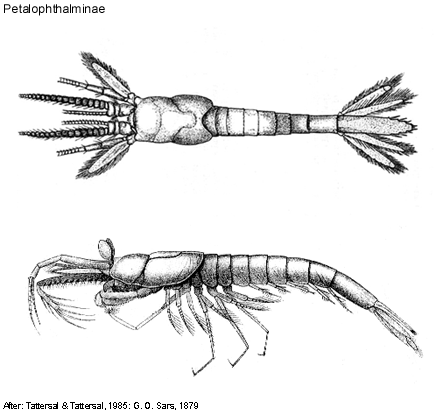 |
||||||
|
|
|
|
|
|
Mysidacea: Families, Subfamilies and TribesKenneth MelandPetalophthalmidae Czerniavsky, 1882 Diagnostic description. Head. Carapace large, only last thoracic somite uncovered, or short, last 2 or 3 thoracic somites exposed dorsally. Rostrum obtuse, or broadly rounded. Eyes reduced (flattened to one or two leaf-like forms). Antenna (antenna 2) scale without apical suture, outer margin serrated, without setae (e.g. Hansenomysis) or outer margin smooth, setose (e.g. Petalophthalmus), without terminal spine. Labrum symmetric. Mandible lacinia mobilis reduced or absent (lacinia mobilis on left and right mandible absent), spine row reduced to a single spine, molar process well developed. Thorax. 1st maxilliped exopod absent. 2nd thoracopod developed as a maxilliped, exopod absent (as in Petalophthalmus) or exopod well developed (as seen in Hansenomysis). 3rd-8th thoracopods endopod with distinct carpus and propodus, propodus unsegmented. Branchiae on thoracopods absent. Marsupium composed of seven pairs of oostegites. Abdomen 6th & 7th abdominal somites fused. Female pleopods uniramous or greatly reduced. Uropod endopod setose around entire margin, statocyst absent; exopod with distal articulation, outer margin entire (e.g. Petalophthalmus) or outer margin with slender and robust setae (e.g. Hansenomysis). Telson apex entire. Generic composition. Petalophthalmidae contains 6 genera (32 species): Bacescomysis Murano & Krygier, 1985 (6 species); Ceratomysis Faxon, 1893 (3 species); Hansenomysis Stebbing, 1893 (15 species); Parapetalophthalmus Murano & Bravo, 1998 (1 species); Petalophthalmus W. -Suhm, 1874 (5 species); Pseudopetalophthalmus Bravo & Murano, 1997 (2 species). Remarks. Based on primitive characters such as seven pairs of oostegites and the absence of a statocyst on the endopod of the uropod, accompanied by derived characters as the reduction of thoracic gills and uniramous female pleopods, Tchindonova (1981) erected the sub-order Petalophthalmida, removing the Petalophthalmidae from the sub-order Mysida. The Petalophthalmidae are deep-water mysids inhabiting both the bathypelagic zone and hyperbenthic as seen in Bacescomysis abyssalis (Lagardère, 1983) and B. peruvianus (Bacescu, 1971) reaching bottom depths of 4500 m in the Bay od Biscay and Peru Trench. Confinement to deeper waters has resulted in varying degree of reduction of the compound eyes in all genera of Petalophalmidae. As in the Eucopiidae the Petalophalmidae have adapted a raptorial feeding habit, and have lost all traces of a filter feeding mechanism in the mouthparts. Manifested in the loss of a filter plate on the maxilla and development of endopodsal meral lobes on the second thoracic limbs. Most recent additions to the Petalophalmidae can be found in Bravo & Murano (1997a,b) and Murano & Bravo (1998) where they have established two new genera and transferred Petalophthalmus australis to Pseudopetalophthalmus..
Cite this publication as: 'Meland, K. (2002 onwards). Mysidacea: Families, Subfamilies and Tribes. Version 1: 2 October 2002. https://crustacea.net'. |
|
|
|
|
|
|
|
|
|
Copyright © Australian Museum, 2002 - 2003
Australian Museum website
